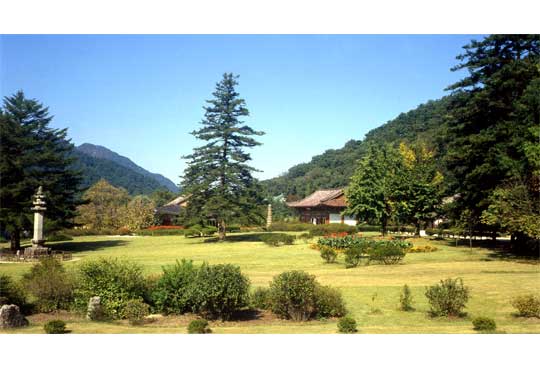Pohyon Temple in Mt Myohyang
Pohyon Temple in Mt Myohyang, Hyangam-ri, Hyangsan County, North Phyongan Province was built in 1042 as a temple of Koryo dynasty and renovated in 1765.
Buildings and pagodas such as Jogye Gate, Haethal Gate, Chonwang Gate, 9-storeyed stone pagoda, Manse Pavilion and 13-storeyed stone pagoda are arranged in succession. Large and small buildings including Kwanum Hall are placed on the left and the right to form a large group of buildings.
It is Taeung Hall that shows the highest architectural technique among the buildings of the Pohyon Temple. The Taeung Hall is a house of gabled roof with double eaves which is 5 bays (20.5m) in front and 3 bays (10.7m) in sides and it is large in scale, compact and sophisticated in the composition of the building elements and its colourful paintings are exquisite.
It was renovated in a large scale in 1765 but burnt down by the bombing of the US imperialists during the Fatherland Liberation War and restored in 1976. Later, other buildings and pagodas including the Manse Pavilion were also restored.
Among the gates of the Pohyon Temple; the Jogye Gate and the Haethal Gate were rebuilt in 1644 and the Chonwang Gate was built from 1775 to 1786.
The roof of the Kwanum Hall is double eaves at the fore front and fore side and the rest is single eaves.
Ryongsan Hall is gabled house with double eaves which is 3 bays (12.8m) in front and 3 bays (7.7m) in sides. It was initially located at about 500 metres east of the Pohyon Temple and moved to present place. The present building was rebuilt in 1875.
The Pohyon Temple has an excellent Archive for the permanent preservation of the national treasured relics, 80 000 Blocks of the Complete Collection of Buddhist Scriptures.
The Pohyon Temple is not only proud of its outstanding architectural technique but also valuable historical relics of the country noted for the patriotic struggle of our people during the Imjin Patriotic War.
